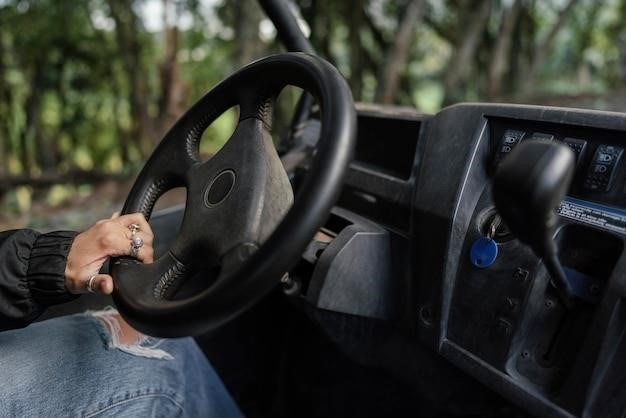
Manual All-Wheel Drive Cars⁚ A Guide
Manual all-wheel drive (AWD) cars offer a unique driving experience that blends the engagement of a manual transmission with the enhanced traction and stability of AWD. This guide will explore the history, benefits, and popularity of manual AWD cars, delving into their use in performance and off-road vehicles, and examining the future of this niche but dedicated segment of the automotive world.
Introduction
In a world increasingly dominated by automatic transmissions and advanced driver-assistance systems, the allure of a manual all-wheel drive (AWD) car might seem like a relic of the past. Yet, for those who crave a more visceral and engaged driving experience, the combination of a manual gearbox and AWD remains a compelling proposition. The act of selecting gears, feeling the engine’s response, and navigating through corners with the precise control of a manual transmission, all while benefiting from the added traction and stability of AWD, creates a unique driving dynamic that resonates with a specific breed of enthusiast. This guide aims to explore the world of manual AWD cars, delving into their history, benefits, and popularity, examining their role in both performance and off-road applications, and considering the future of this niche yet passionate segment of the automotive landscape.
While the convenience and efficiency of automatic transmissions have made them the dominant choice for most drivers, manual transmissions still hold a special place in the hearts of many, particularly those who appreciate the tactile connection and driver engagement they provide. AWD, on the other hand, offers a significant advantage in terms of traction and stability, especially in challenging weather conditions or when driving on slippery surfaces. The combination of these two elements, a manual transmission and AWD, results in a driving experience that is both engaging and capable, appealing to those seeking a balance of control and performance.
The appeal of manual AWD cars extends beyond their inherent driving characteristics. They often represent a link to a bygone era of driving, where the driver was more intimately involved in the car’s operation; This nostalgic connection, coupled with the inherent performance and capability of these vehicles, has fostered a dedicated community of enthusiasts who appreciate the unique qualities they offer.
This guide will delve into the fascinating history of manual AWD cars, exploring the evolution of this technology and the iconic models that have defined the segment. We will also examine the numerous benefits of manual AWD, from enhanced performance and handling to improved fuel efficiency and off-road capabilities. Finally, we will explore the future of manual AWD, considering the challenges and opportunities that lie ahead for this captivating segment of the automotive world.
The History of Manual AWD Cars
The journey of manual all-wheel drive (AWD) cars is a captivating one, tracing back to the early days of automotive innovation. While the concept of AWD itself predates the widespread adoption of manual transmissions, the marriage of these two technologies was a pivotal moment in the evolution of performance and off-road vehicles. The story begins in the 1980s, with the advent of iconic models like the Audi Quattro and the Subaru WRX, which popularized the concept of manual AWD in the performance car segment. These vehicles showcased the potential of AWD for enhanced traction, grip, and handling, particularly in challenging conditions like snow and ice.
The Audi Quattro, introduced in 1980, was a revolutionary car that redefined the performance landscape. Its permanent AWD system, coupled with a manual transmission, provided exceptional grip and handling, making it a dominant force in rallying and establishing Audi as a pioneer in the world of high-performance AWD vehicles. The Subaru WRX, launched in 1992, followed a similar path, using a manual transmission and symmetrical AWD system to deliver a potent combination of performance and all-weather capability. These early models paved the way for a new era of performance cars that could handle any terrain, challenging the traditional rear-wheel drive dominance in the sports car world.
As time progressed, the concept of manual AWD spread beyond high-performance cars, finding its way into off-road vehicles, SUVs, and even some mainstream models. The Jeep Wrangler, with its rugged off-road capabilities and available manual transmission, became a symbol of adventure and all-terrain prowess, while the Subaru Outback, with its practical wagon body and AWD system, offered a blend of everyday usability and off-road capability.
The history of manual AWD cars is marked by innovation, evolution, and a growing appreciation for the driving experience it offers. From the early pioneers like Audi and Subaru to the diverse range of models available today, the appeal of a manual gearbox and AWD remains a testament to the enduring power of this unique combination.
Benefits of Manual AWD
Manual all-wheel drive (AWD) cars offer a unique blend of driving engagement and enhanced capability, making them an attractive option for enthusiasts and practical drivers alike. The benefits of this combination extend beyond mere performance, encompassing a range of advantages that enhance the overall driving experience.
One of the most prominent benefits of manual AWD is its ability to deliver superior traction and stability, particularly in challenging conditions like snow, ice, and wet surfaces. The constant power distribution to all four wheels provides a significant advantage in maintaining grip and control, making the car more confident and predictable in slippery situations. This enhanced traction not only improves safety but also allows for more aggressive acceleration and cornering, particularly in off-road environments.
Beyond enhanced traction, manual AWD offers the driver a greater sense of control and engagement. The manual transmission allows for precise gear selection, maximizing engine performance and providing a more direct connection to the car’s powertrain. The ability to choose the optimal gear for different driving situations, combined with the AWD system’s responsiveness, creates a more dynamic and rewarding driving experience.
For enthusiasts, the combination of manual transmission and AWD offers a unique blend of performance and control. The manual gearbox allows for a more engaging and visceral driving experience, while the AWD system provides the confidence to push the car’s limits in challenging conditions. This combination is particularly appealing in performance cars, where the ability to manage power delivery and maintain grip is crucial for achieving optimal performance.
The benefits of manual AWD extend beyond performance and handling, encompassing aspects of practicality and versatility. The increased traction and stability offered by AWD make the car more capable in a variety of weather conditions, reducing the need for specialized winter tires and providing a more confident driving experience year-round.
Popular Manual AWD Cars
While the availability of manual transmissions in conjunction with all-wheel drive (AWD) systems has been steadily declining in recent years, a dedicated selection of popular models continue to offer this engaging combination for enthusiasts and practical drivers alike. These vehicles represent a diverse range of segments, showcasing the enduring appeal of manual AWD in both performance and everyday driving scenarios.
In the performance car realm, iconic models like the Porsche 911 Carrera 4S and the Volkswagen Golf R remain steadfast champions of manual AWD. These high-performance machines offer a thrilling blend of power, handling, and driver engagement, making them highly sought after by those seeking a pure driving experience.
Subaru has long been a prominent advocate for manual AWD, particularly in their WRX and Impreza models. These vehicles are renowned for their rally-bred heritage and all-weather capability, offering a balance of performance and practicality that appeals to a wide range of drivers.
Beyond the performance segment, manual AWD cars continue to be offered in a variety of everyday vehicles. The Subaru Outback and Crosstrek, for example, provide a blend of practicality and capability, offering the advantages of AWD for off-road excursions and inclement weather conditions, while still providing a comfortable and spacious interior for everyday use.
While the availability of manual transmissions with AWD has been shrinking in recent years, the dedicated models that remain represent a testament to the enduring appeal of this unique driving experience. These cars continue to offer a blend of performance, capability, and driver engagement that resonates with those who value a more visceral and connected driving experience.
Manual AWD in Performance Cars
The combination of a manual transmission and all-wheel drive (AWD) has long been a cherished recipe for enthusiasts seeking a thrilling and engaging driving experience in performance cars. This pairing offers a unique blend of driver control, power delivery, and enhanced traction, making it a highly sought-after feature in the world of high-performance automobiles.
Manual transmissions, with their direct connection to the engine and the ability to precisely select gears, allow drivers to fully exploit the power and torque characteristics of performance engines. The tactile feedback and the sense of control inherent in manual shifting add a significant element of engagement and driver involvement, enhancing the overall driving experience.

AWD systems, on the other hand, provide a significant advantage in handling and traction, especially in challenging conditions. By distributing power to all four wheels, AWD systems enhance grip and stability, allowing drivers to push the limits of performance with greater confidence. This is particularly beneficial in situations where traction is limited, such as on slippery surfaces or during aggressive cornering.
When combined, manual transmissions and AWD systems create a symphony of performance and driver engagement that is difficult to replicate with other drivetrain configurations. This synergistic pairing allows drivers to exploit the full potential of a performance car, delivering both thrilling acceleration and exceptional handling, making it a popular choice for enthusiasts seeking the ultimate driving experience.
Manual AWD in Off-Road Vehicles
While automatic transmissions have become increasingly popular in off-road vehicles, the allure of a manual transmission for off-road enthusiasts remains strong. Manual AWD offers a level of control and driver engagement that can be highly beneficial in tackling challenging terrain.
The ability to precisely select gears and manage engine speed allows drivers to fine-tune power delivery and control wheel spin, which is crucial when navigating obstacles and traversing uneven surfaces. A manual transmission provides a more direct connection to the vehicle’s drivetrain, allowing drivers to feel and anticipate the vehicle’s response to the terrain;
In off-road situations, where traction is often limited, the ability to carefully modulate engine speed and gear selection can be invaluable. By selecting the appropriate gear, drivers can optimize torque delivery to the wheels, maximizing traction and minimizing wheel slip, especially when climbing steep inclines or negotiating slippery descents.
Furthermore, the precise control offered by a manual transmission allows drivers to maintain momentum and navigate tricky sections of terrain with greater confidence. The ability to quickly downshift and engage the engine’s braking power can be crucial for managing descent speeds and maintaining control on challenging trails.
While automatic transmissions have made strides in off-road capability, many enthusiasts still favor the tactile feedback and control provided by a manual transmission. For those who seek a more engaging and rewarding off-road experience, the combination of manual AWD remains a highly compelling option.
The Future of Manual AWD
The future of manual AWD remains a topic of debate and speculation within the automotive industry. While the trend toward automatic transmissions and advanced driver-assistance systems continues, a dedicated group of enthusiasts champions the continued existence of manual AWD vehicles.
The increasing focus on fuel efficiency and emissions regulations has led some manufacturers to prioritize automatic transmissions, as they offer better fuel economy and smoother driving experiences. Additionally, the rise of autonomous driving technology has further fueled the shift toward automated systems. However, there are compelling reasons to believe that manual AWD will continue to have a place in the automotive landscape.
The inherent driving pleasure and engagement offered by manual transmissions, coupled with the enhanced control and performance of AWD, remain highly valued by a passionate community of drivers. The tactile feedback and the ability to precisely control the vehicle’s power delivery continue to appeal to enthusiasts seeking a more direct and involved driving experience.
Moreover, the increasing popularity of off-roading and performance driving further supports the need for manual AWD options. In these demanding driving environments, the precise control and driver engagement offered by a manual transmission can be invaluable.
While the future of manual AWD may face challenges from evolving technology and market trends, its dedicated following and enduring appeal suggest that it will continue to hold a niche but significant presence in the automotive world, offering a unique and rewarding driving experience for those who value driver engagement and control.



